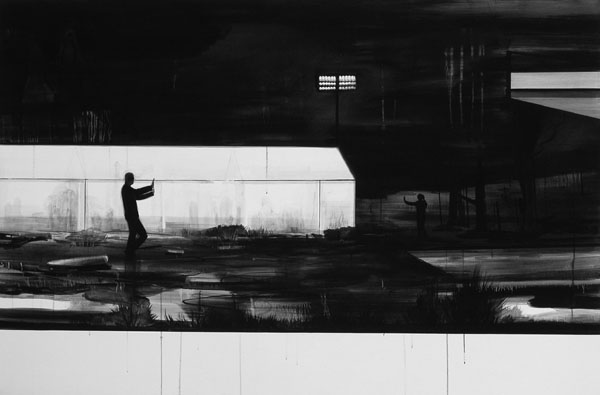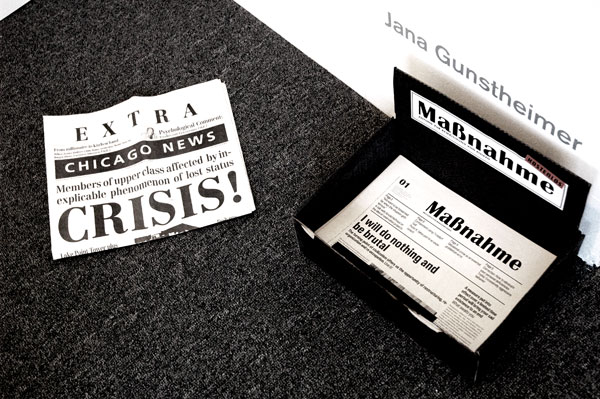
Jana Gunstheimer Reservat 2003 acrylic on linen 46.5" x 69.75" [work not at Scope]
I'm not sure that it should be necessary to mention it, even if it may be germane (no pun intended), but Jana Gunstheimer, described by her Swiss gallery Römerapotheke as an artist and ethnologist, was born in Zwickau, in what was then known as East Germany, or the Deutsche Demokratische Republik. In the years immediately following the precipitous disappearance of that communist state she studied painting in Leipzig. Today she lives in Jena, near Weimar. She's known in Europe [and in Philadelphia {scroll down}] mostly for her beautiful black and white expressionist painting. We haven't had nearly enough opportunity to see it on this side of the Atlantic.

Jana Gunstheimer [large detail of installation at Scope]
The image just above is of items from the artist's physically very different body of work, "Heiligsprechung" [Canonization], a part of which was brought to Scope New York this year by Römerapotheke. No, the two framed watercolors don't represent attempts to display divine stigmata, but are merely protestations of the negative, "ich tu dir nichts" [I did nothing to you] or "Ich pass auf dich auf" [I leave it to you]. Gunstheimer's general conceit is described just below in a large excerpt from the press release for her current show at Filiale in Berlin. Note that "SBK" is the German-language acronym for her fictive Austrian department of government, "State Authority for National Heroes".
SBKLast year she came to Chicago for her first show in the U.S.State Authority for National Heroes
In 1976 Austria's federal government was planning to set up a "canonization" authority as part of the celebration of 1000 years of the country's existence (the process is known as "beatification" in the Roman Catholic church). After due examination, exceptional people would be granted access to high public esteem and entry in the annals of popular or national heroes.
However, the real reason for setting up such an authority was the prospect of high revenue in the form of voluntary payments by citizens. In fact the minimum costs of thorough examination of each application, expert appraisal, reimbursement of witness expenses, production of documentation, printing, decoration during the ceremonies and multiple fees and taxes were calculated at 80 000 shillings.
In the first year alone, the Authority received well in excess of 1000 applications. In many places, associations were formed to sponsor candidates of slender financial means and give the member of their community a chance of becoming an official popular hero.
As it happened, none of the applicants in the first year was deemed worthy of elevation to this rank. Indeed, in the next five years of the authority's existence, only three candidates made the grade. Instead, the Authority's examination revealed not only that applicants were not popular heroes, but that most had committed major or minor offences. Faithful to their obligation of disclosure, they had allowed the Authority access to all spheres of their lives.
Establishing the Authority was an ideal ploy for a government. Citizens pay large voluntary sums into government coffers and actually turn themselves in.
She is known for her observation of and creative satire of the weaknesses within both German and Austrian society and culture, but at the Chicago Institute of Arts she made a very successful incursion into the frailties of our own. The Chicago Reader's review described her project with a headline which reads like it might have been inspired by New York's Daily News: "The upper classes take a dive in Jana Gunstheimer's clever disaster scenario.".
THE CENTRAL WALL in Jana Gunstheimer's installation at the Art Institute features a large cutout of the Tribune's logo accompanied by a giant, delicately executed silhouette of a dilapidated high-rise. The ominous headline is "Status L Phenomenon" -- also the title of the exhibit. A stack of newspapers, which visitors may take with them, announces "Members of upper class affected by inexplicable phenomenon of lost status." A smaller headline reads "Lake Point Tower plus two luxury villas suddenly replaced by affordable homes -- Occupants seem different."

Jana Gunstheimer [view of installation at Scope]
The image shown just above is of a stack of two editions of the artist's newspaper, Massnahme. She plans a series of eight editions, each related to issues of unemployment. There will be an interval of two years between each, corresponding to the duration of the German government's current program for people unable to find work. The Issue on the left was created for the Chicago show, and may in fact be an "extra". The stack on the right is of copies of issue #1; its headlines describe, along with other stories, an experiment inside a "containment camp".
I want to see more of Gunstheimer. If she can be so disturbed by, and address so well, the dark side of what we often perceive as the remarkable success stories of Germany and Austria I can't begin to imagine what she could accomplish here in our benighted American homeland.
[image at the top from Galerie im Kunsthaus Essen]
UPDATE: D-L Alvarez has a review of Gunstheimer's current Berlin show in the ArtCal Zine, and in his blog "Modern Art Notes" Tyler Green discusses the artist's show at the Art Institute of Chicago, both items posted today, April 18.